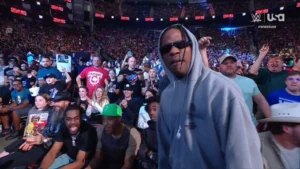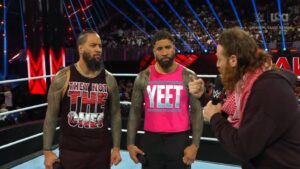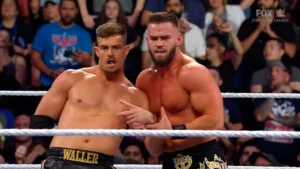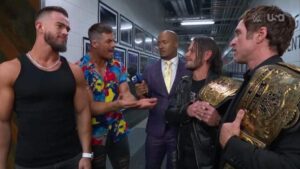It is finally here! Season 3 of Dark Side of the Ring began all the way back on May 6th, 2021. It was a season which began with a two-part episode (counted as episodes 1 and 2 of season 3) on the life and death of the late, great Brian Pillman. 13 episodes later, after having visited near-disasters in North Korea; Yakuza influenced hardcore wrestling promotions in Japan, as well as personal visits to the late Chris Kanyon and Luna Vachon, to name just two, season 3 has drawn to a close. There is no better way for a season of Dark Side of the Ring to go out than with a look at the WWF steroid trials – potentially the most hotly-anticipated episode of the show to date. As always, let’s jump in and run down this mega season finale.
In the '90s, the US government attempted to take down Vince McMahon and the WWF amid a series of steroid scandals.
The season finale episode: “The Steroids Trials,” premieres Thursday at 9pm on @vicetv. pic.twitter.com/pK9xq6q77N
— Dark Side of the Ring (@DarkSideOfRing) October 25, 2021
The Steroid Trials – What We Learned About the Steroid Trials of the 1990s dubbed the “United States Vs. Vince McMahon”
Background Information
The steroid trials of the mid-1990s were a series of trials brought forward by the federal government to indict WWE (then WWF) chairman, Vince McMahon, on the grounds that he had been supplying anabolic steroids to professional wrestlers under the WWF umbrella. Six charges were brought forward – with three being thrown out before any actual trial was sat. Those three which made it to court were two counts of distributing steroids and one count of conspiracy to distribute steroids. The trial was also noteworthy for Hulk Hogan‘s role as a witness which, as we will learn about later, was as complex as his relationship with McMahon at this time. Vince McMahon was, of course, found not guilty – a victory which he himself has referred to as the “United States Vs. Vince McMahon”.
Jerry McDevitt, ESQ
We cannot look at the steroid trials without knowing who Jerry McDevitt, ESQ, is. After Chris Jericho‘s weekly introduction concludes, the episode begins with WWE’s long-standing lawyer, Jerry McDevitt, who is the star of this particular episode. He has been WWE’s attorney for “over thirty years”, per McDevitt himself. It becomes obvious here that aside from being WWE’s lawyer, McDevitt is a close friend of the WWE and McMahon personally – who, as shown by McDevitt through a photograph in his office, invited Vince to his wedding, such is their friendship. Jim Ross describes McDevitt as “the most intelligent man I have ever met.” Wade Keller of Pro Wrestling Torch here describes McDevitt as tall, brash and fearless in court. Essentially, he is an elite level lawyer.
Hulk Hogan
We then begin looking at Hulk Hogan – a star who needs no introduction but, given his prominent role in the steroid trials, it is essential he is covered, also. Dave Meltzer of the Wrestling Observer Newsletter states that without Hulk Hogan, there is no Vince McMahon – both men made each other during the “Golden Era” of the 1980s. Self-described “wrestling historian” Joe Arezzi of Pro Wrestling Spotlight follow on from Meltzer in describing how, during the 1980s, the physiques of pro wrestlers became “more and more cartoonish”; they were becoming bigger, with the characters they portrayed being more akin to a comic book (Ultimate Warrior) than the wrestling promotion Vince McMahon inherited from his father less than a decade before. Of course, this would be more than enough reason for the WWF to be suspected of heavy steroid use.
Terry Szopinski – The Warlord
In what is a pretty cool get for Dark Side, Terry Szopinski, better known as the larger than life WWF character of The Warlord, makes an appearance here. He declares how wrestlers at that time had become so large that they could have formed a football team – “nobody would be able to touch us.”
90% of Wrestlers on Steroids
Joe Arezzi mentions here that around 90% of wrestlers around this time were on some form of anabolic steroid. A shocking statistic which, of course, is hardly surprising – anyone who has seen 1980s wrestling could believe quite easily that most wrestlers were on steroids at this time. Dr George Zahorian, responsible for examining wrestlers in the WWF, had a “big doctor bag” filled with steroids, per Warlord. It becomes clear, here, that Zahorian was more akin to a drug dealer than a doctor. Former pro wrestler, Brian Blair – who was one half of the Killer Bees in the WWF – runs down a number of drugs Zahorian was prescribing to WWF superstars at the time. He also adds that wrestlers were under tremendous pressure to look the best they possibly could, which no doubt played a part in steroid use.
Steroids Becomes a Controlled Substance
A simple Google search of the legality of steroids in the United States will tell you that “the Anabolic Steroids Control Act of 1990 placed anabolic steroids into Schedule III of the Controlled Substances Act (CSA) as of February 27, 1991″ per the DEA. Therefore, as McDeviitt said, in 1990, anabolic steroids became – for the first time – a controlled substance. Then-weightlifting coach, Bill Dunn, was targeted by the FBI and forced to hand over his supplier of anabolic sterois, WWF’s Doctor Zahorian, who, per McDevitt, “flipped” and became a government witness. Zahorian was wired. He was caught prescribing steroids to Dunn who, as a weightlifting coach, was passing them on to his students – students who were mostly teenagers or “kids”, as McDevitt says. News of this reaches the desk of Vince and Linda McMahon, with the latter then demanding that Zahorian never work in the WWF again.
FBI Investigation
Brian Blair was personally visited by the FBI – who understood that Blair, among many others, had been connected with and supplied steroids by Dr. Zahorian by federal mail. Blair was given the option that he could come and testify and never be prosecuted himself, which he, of course, agreed to.
FBI Comes for Hogan
Hulk Hogan was, at this time, the biggest name in professional wrestling; a pop culture icon whose name transcended the sport itself. It only made sense, then, that the FBI would become interested in Hogan, too. However, Hogan never made it to the Zahorian trial – McDevitt states that Hogan and Zahorian had a traditional “doctor/patient relationship” and it didn’t make sense for Hogan to be present for court proceedings. Phil Mushnick, a sports columnist of the New York Post who covered the steroid trials at the time, believes that Hogan only avoided the trial – under the advice of lawyers, McDevitt included – to protect both himself and his career. McDevitt says he received a call from a person in the media who said “President Ronald Reagan had to testify in the Oliver North case despite not wanting to testify, how did Hulk Hogan get out of testifying?” to which McDevitt replied “maybe Reagan had the wrong lawyer.”
Zahorian Found Guilty
Dr. Zahorian is found guilty of providing steroids to wrestlers not classed as official patients. Whereas Zahorian took the fall, this would not stop investigations from becoming progressively worse for Vince McMahon and the WWF. McMahon would respond by announcing a wellness policy which would actively be testing for steroids – making the WWF a “standard bearer for non-steroid use in the sports world” per McMahon himself.
Hogan on the Arsenio Hall Show
McDevitt jokes (though he’s not really joking) that he can’t discuss what he informed Hogan to say (or avoid saying) on the Arsenio Hall Show, adding that it’s “client privilege” that he doesn’t tell. Having watched the clip, though, it becomes clear that McDevitt likely informed Hogan to avoid being brash and to politely and articulately claim that he did in fact take steroids on three occasions, but for muscle injuries in which steroids might normally be prescribed – whilst making it clear that he’s not a steroid abuser. This is speculation, however, and not to be considered fact. As Keller says, it did not pass the “public sniff test” and it would soon draw more unwanted attention to the WWF. Meltzer and Arezzi would later catch McMahon in a lie on the David Donahue Show, after he had claimed to Meltzer, personally, that he was “devastated” over Hogan’s lie on the Arsenio Hall Show – but McMahon denied it on the show, which was caught out.
Arezzi Receives a Visit
Two gentlemen turned up at Arezzi’s house, asking to speak to John Arezzi and informing his mother that “Arezzi lives in a dangerous neighborhood” – essentially a warning to tread carefully. However, McDevitt counters this claim by stating Arezzi and “these guys” have a “wild imagination” and that nobody as high up as himself or McMahon would care to harm “a John Arezzi”. He adds that it’s a story guys like Arezzi make up to give themselves “an importance that they have never had.” McDevitt then follows up by making it clear he and McMahon believed the entire thing to be a “witch hunt” – with Mushnick singled out for writing a number of hit pieces on the WWF and McMahon at the time.
“Prepare For What You Know Is Gonna Come”
McDevitt states that for the next 18 months, he was under the impression that the WWF was being “stalked” by the FBI; he began learning everything there is to learn about steroids as the best course of action is to always “prepare for what you know is going to come.” A side note here: it is becoming more and more apparent throughout this episode that McDevitt is every bit the lawyer he was made out to be by Jim Ross in the opening of the episode. Well done to VICE and Dark Side of the Ring for getting him on board for the episode.
Mushnick is Followed
Phil Mushnick claimed he was trailed by Fairfax Partners (believed by Mushnick to be hired by McMahon’s representatives), a group of former FBI agents, because they were trying to “get anything they can on me.” Mushnick goes on to further claim that on one instance, he actually met up with a couple of these former agents tracing him – they laughed and drank together. The agent apparently turned to Mushnick and said “you’re a nice guy but we’re going to keep trying to take you down.” Mushnick laughed back and said “I smoked a lot of pot in college, take me down” – they laughed about this together. This feels like a scene straight out of a Tarantino movie.
James Stewart – Limo Driver Turned Special Delivery Driver
Vince McMahon’s personal limo driver from that time, James Stewart, was called as a witness to testify; claiming that he was ordered by McMahon to deliver a crate of steroids to Hulk Hogan, personally. However, McDevitt managed to get Stuart taken off the stand, after he had allegedly (Stuart was unable to be reached for comment) been caught in perjury by McDevitt. “They didn’t want to put anyone on the stand who had committed perjury”.
Shift Away From Hulk Hogan
With the WWF now unable to rely on steroids to create and sustain the larger than life appearances of its superstars, it had to “move younger” – into a New Generation. Vince McMahon realized that he could no longer have Hulk Hogan as the centerpiece, as a steroid-free, diminished Hulk Hogan would draw negative attention to the company. Hulk Hogan would then depart the company in November of 1993. McMahon, after 18 months, would finally be indited – a decision welcomed by McMahon and McDevitt as it meant they could finally put an end to this.
The Neck-Brace
Quick side note: Vince McMahon turned up to trial in a neck-brace, to generate what is described as “babyface sympathy” in his battle against the United States. It looked silly but it seemingly helped matters. McDevitt acknowledges, however, that he had recently had neck surgery – he was wearing it for legitimate purposes.
Court Strategy
Because of Jerry McDevitt’s prior representation of Hogan at the Zahorian trial, his role is regarded as a “conflict of interest”, meaning McMahon’s team would need to reshuffle, assess its strategy and bring in outside assistance. Laura Brevetti, a former Federal Prosecutor, was brought into the team. McDevitt states that the plan was for him to represent WWE as an organization, with Brevetti representing Vince McMahon himself. They would rely on Brevetti’s cross examination of Hogan so that they couldn’t use McDevitt’s prior representation to knock him out of the case.
Zahorian Tesifies Against McMahon… Dirty Tactics Involved
Dr. Zahorian is brought in to the courtroom from his cell, so that he could testify against Vince McMahon. However, a letter is uncovered which reveals some of the darker, more twisted methods to force someone to testify. As recounted by McDevitt, Zahorian was taken to a number of tougher prisons around the State – prisons reserved for the most violent and dangerous of offenders. This was presumably done to intimidate Zahorian. Then, when asked to testify and admitting that he could not because he was unaware of any conversation he was alleged to have had with McMahon, he was taken away and threatened with a tape recording, between he and Dunn, which could further extend his sentence on the basis of selling (second-hand) steroids to children. Then, and only then, did he “recall” such conversation. This conversation then becomes the sole method of bringing down Vince McMahon. Zahorian then denied that his treatment was malicious or influenced his testimony.
Hulk Hogan is Sworn In
Hulk Hogan was seen as the personality who could do the most damage. At this time, Hogan was working for the WWF’s chief rival, World Championship Wrestling (WCW). Hogan was granted immunity for anything he would reveal on the stand about how he got his steroids from Zahorian whilst working for McMahon. The belief was that Hogan would come into the courtroom would “bury” Vince McMahon and send him to prison for years. In a shocking turn of events, Hogan would go the other way; recounting his friendship with McMahon, that they were gym buddies, and that Vince was not personally responsible for the prescription of steroids – essentially exonerating McMahon of the charges against him. Despite Hogan saving McMahon from prison, Meltzer states that McMahon remained furious that Hogan had testified against him – there’s gratitude for you.
Sean O’Shea Gets Desperate
Sean O’Shea, the former head of the Business and Securities Fraud section of the U.S attorney’s Brooklyn office, begins to get desperate in court; throwing around what McDevitt deems to be accusations and terms which would normally get someone thrown out of court – terms such as “corporate drug dealer”. Dave Meltzer acknowledges that, though fiery, it made for a great pro wrestling promo. O’Shea goes on to attack McMahon further, claiming his personal wealth – then “hundreds of millions of dollars” – was made off ofthe backs and hard work of those wrestlers forced to take drugs and hurt themselves for his empire. This became his argument to bring McMahon down.
Oxandrolone Anavar
Oxandrolone, sold under the brand name “anavar”, is a drug deemed “unfit for human consumption” and necessary to be “removed from the market”. McDevitt came to understand that many of those called into testify on this case had been under the influence of anavar. “It demonstrates how inept they were in regulation when the internal memos say that anavar is unfit from human consumption and should be removed from the market” says McDevitt, who revealed his findings to the judge. It honed in on the unfair, hypocritical treatment the WWF and Vince McMahon were being subjected to. Again demonstrates the legal genius of McDevitt, who claims “I did not spend one minute of my time thinking about losing.”
The Verdict
The first verdict was on the one for Vince McMahon, who was being represented by Brevetti – it was revealed that Vince had been found “not guilty”. McDevitt then had the nervous, anxious wait to find out whether the WWF, who he was representing, had been similarly found not guilty. The company, of course, was found “not guilty” – the precise moment of which is framed in McDevitt’s office, in the form of a courtroom drawing. The verdict was very popular. As Meltzer states here, though McMahon and his team have framed it as a tremendous victory for McMahon over the United States, he was only found not guilty of conspiracy; it was still revealed that the entire WWF roster of the time period was taking ridiculous amounts of steroids. It was a Pyrrhic victory, at best.
Conclusion
Vince McMahon and the WWF, now WWE, won the war – his bond with lawyer Jerry McDevitt is deemed “unbreakable” by the man himself. When you go to war, you maintain a close bond with your comrades for life and that is evidently how the relationship is viewed by McDevitt. However, despite winning the war, it became clear that steroid use in wrestling is unsustainable; the WWE can never return to the days of shady doctors and overtly drugged up professional wrestlers. It is a common theme throughout Dark Side of the Ring that nearly all of the tragic tales covered involved drugs, steroids included, in some way. The WWE, AEW and more must keep it clean in order to ensure the protection of its star performers, so they can live long enough to enjoy the fruits of their labor.
That concludes Season 3 of Dark Side of the Ring. If you have enjoyed our weekly run down of the series, please come back for more of our content. Should Dark Side of the Ring Season 4 eventually be announced, we can guarantee that, when the time comes, we will undoubtedly return to our run down series for that season, just as we have done for this and previous seasons.
More From LWOS Pro Wrestling
Stay tuned to the Last Word on Pro Wrestling for more on this and other stories from around the world of wrestling, as they develop. You can always count on LWOPW to be on top of the major news in the wrestling world, as well as to provide you with analysis, previews, videos, interviews, and editorials on the wrestling world. Catch Dark Side of the Ring on VICE, with new episodes airing each Thursday at 9 PM EST.






